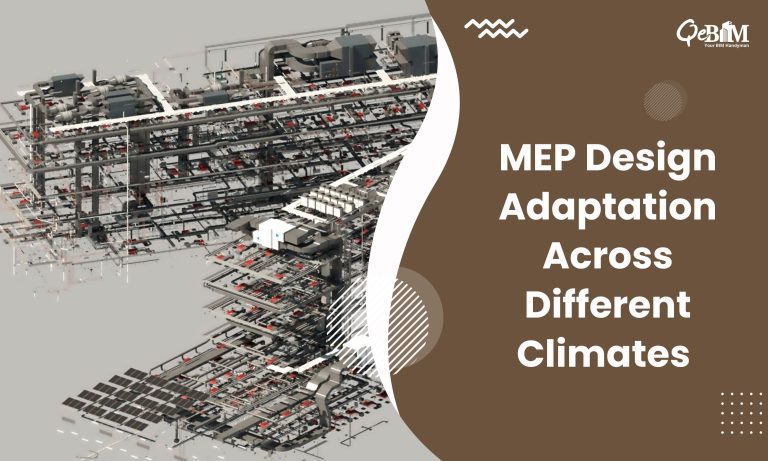MEP Design Adaptation Across Different Climates

In the area of building design and planning, the MEP systems plays an important role in ensuring comfort, functionality, and sustainability. However, designing the MEP systems is not a one-size-fits-all project, especially when considering the diverse climates and environmental conditions across the globe. Adapting the MEP design to different climates and regions is essential for optimizing energy efficiency, maintaining indoor comfort, and ensuring longevity of the building infrastructure.
Understanding Regional Climate Variations
Climate significantly influences the requirements and challenges of MEP systems. For instance, buildings in hot and humid climates require robust HVAC systems capable of managing high temperatures and humidity levels efficiently. On the other hand, buildings in cold climates necessitate heating systems that can effectively maintain indoor warmth without excessive energy consumption. Moreover, the regions prone to any seismic activity or extreme weather events like hurricanes require MEP designs that prioritize structural resilience and safety. All of this can be achieved by opting for accurate MEP BIM Services and testing for the design iterations as per the regions.
Key Considerations in MEP Design Adaptation
- HVAC Systems: Heating, Ventilation, and Air Conditioning (HVAC) systems are perhaps the most critical component in MEP design adaptation. In warmer climates, emphasis is placed on cooling capacity, humidity control, as well as energy efficiency. Utilizing technologies such as variable refrigerant flow (VRF) systems and evaporative cooling can significantly enhance performance in such regions. Conversely, in colder climates, efficient heating solutions such as heat pumps, radiant heating, and energy recovery ventilation (ERV) systems are prioritized.
- Building Envelope: The building envelope including insulation, glazing, and shading devices, plays a crucial role in reducing the heat gain or loss depending on the climate. In hot climates, high-performance insulation and reflective roofing materials can cut down the heat transfer, reducing the load on HVAC systems. In colder climates, properly insulated walls, windows, and roofs prevent heat loss, enhancing the effectiveness of heating systems.
- Water Management: Plumbing systems must be designed with consideration for local water availability, quality, and usage patterns. In regions experiencing water scarcity, the MEP designs may incorporate water-efficient fixtures, greywater recycling systems, and rainwater harvesting to minimize the demand on municipal water supplies.
- Electrical Systems: Electrical systems should be designed to accommodate local voltage standards and reliability expectations. In the areas prone to the power outages or fluctuations, backup power generation and uninterruptible power supply (UPS) systems become critical components of MEP design.
- Sustainability: Irrespective of the climate, sustainable MEP design principles such as energy efficiency, use of renewable energy sources, and lifecycle cost analysis should be integrated. For example, incorporating solar panels in sunny climates or geothermal heating systems in regions with accessible underground heat sources can significantly reduce carbon footprints and operational costs.
Case Studies in Adaptation
- Tropical Climates: Buildings in Southeast Asia often integrate passive cooling techniques like natural ventilation and shading to minimize reliance on mechanical cooling systems. Modern designs also incorporate energy-efficient HVAC systems with advanced controls to optimize indoor environmental quality.
- Desert Climates: In regions like the Middle East, where temperatures soar during summer months, MEP designs focus on efficient cooling using technologies such as district cooling and thermal energy storage. Building orientation and facade design are critical to reduce solar heat gain.
- Cold Climates: Scandinavian countries emphasize more on building the envelopes with high thermal resistance and efficient heat recovery systems to maintain the indoor comfort during harsh winters. Ground-source heat pumps and solar thermals are commonly integrated into MEP designs for sustainable heating solutions.
Conclusion
Adapting MEP design for different climates and regions is a multidimensional challenge that requires an integrated approach encompassing climate analysis, architectural considerations, technological innovation, and sustainability goals. By tailoring MEP systems to local environmental conditions and building requirements along with the apt BIM Coordination Services, the designers can achieve optimal performance, enhanced comfort, and reduced environmental impact. As the global focus on sustainability intensifies, the role of MEP design in fostering energy-efficient and resilient buildings becomes increasingly pivotal in shaping the future of the built environment.
In all, effective MEP design adaptation not only addresses immediate climate challenges but also contributes to long-term environmental and resource conservation, ensuring that buildings remain functional and comfortable across diverse geographical contexts.